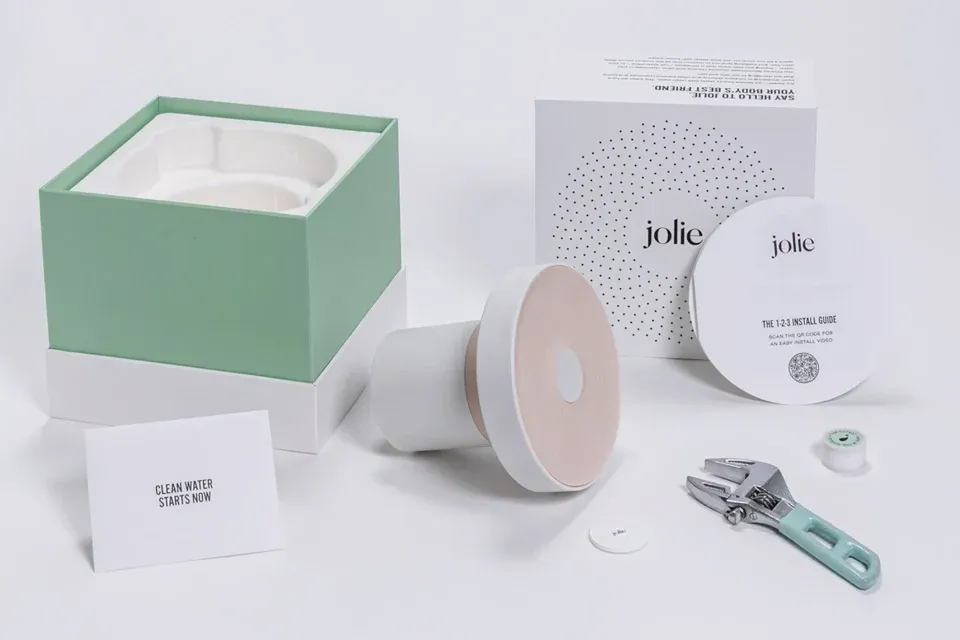The Jolie Story: How a Showerhead Sparked a Wildfire of Success with $4.2M in First-Year Sales

Taking a different tack on the first year
Jolie, a company that sells filtered showerheads, is a beauty startup, but it is not a direct-to-consumer business. Products have been available on Amazon, Gwyneth Paltrow's Goop, and in select hair salons since the company's launch in December 2021.
However, CEO Ryan Babenzien's experiences with the problems encountered by his previous startup, the digitally native sneaker brand Greats, inspired him to create Jolie. Greats was acquired by Steve Madden in 2019 after the company reached about $13 million in revenue, the majority of which came from Greats' direct-to-consumer (DTC) channel.
Having learned the ins and outs of scaling a digital native startup, Babenzien hopes to use that experience to dominate a new market with Jolie. To capitalize on the spread of user-generated content, it is important to have a product that people are eager to praise and talk about. In its first full year of operation after launching in December 2021, Jolie achieved profitable sales of more than $4 million. As more and more brands encounter the constraints of the DTC model, such as high customer acquisition costs, the young startup's trajectory is one that many are looking to emulate.
Our goal all along was to create a successful business. We've done that in the first year, and that's the way we plan to keep doing business," Babenzien said.
Along with former consultant Arjan Singh, Babenzien founded Jolie. He explained that the first few months were funded solely through personal savings, but that they have since raised "a small amount of mostly non-institutional capital in the form of Safe notes."
Babenzien revealed to me that while brainstorming for his next startup idea, he followed these three principles. For starters, he was looking to market an item that could fit anyone, regardless of size. "Once you build an online-first footwear brand, you learn a lot about the... inefficiencies of building a business with things that have multiple sides," he explained. Second, he aimed to create a product that would be simple enough to be incorporated into people's daily lives.
Last but not least, he hoped to find something that catered to his ego. Vanity, he continued, was a major factor in many people's purchasing decisions.
In the end, he decided on a shower. To be more precise, showerheads. The idea behind Jolie's showerhead filter is that clean water is the foundation for a beautiful shower experience.
We are improving not only your health but also your outward appearance. "And that's a really potent product," Babenzien emphasized.
When customers subscribe to the filtered showerhead service, they pay $148 initially and then $33 every three months for a new filter. Customers who choose not to subscribe will have to pay $165 for the showerhead.
Turning the tables, nearly 80% of Jolie's customer base is comprised of subscribers, with a churn rate of only 3% thus far. Amazon accounts for about 12% of total revenue.
According to Babenzien, Jolie's paid marketing strategy begins with user-generated content, despite the fact that the company has relied on paid advertising to acquire customers in its first year, primarily through Google and Facebook.
Paid becomes a "very difficult channel" if "you don't have a big organic conversation [already] happening," as Babenzien put it.
According to Babenzien, Jolie's customers have created 4,000 pieces of user-generated content across Instagram, TikTok, and other social platforms in the company's first year of operation. Some of it does come from influential people who were given free samples of the product to use.
"we certainly communicate that if you're happy with Jolie, share it with your friends," Babenzien said, indicating that the company does not actively influence what users post about.
User-generated content includes testimonials from people whose skin and hair have improved after using Jolie. Some of them are unboxings, and others are just regular reviews. Another common method involves the customer installing the showerhead themselves with the help of the aesthetically pleasing tools Jolie provides for said installation, such as a mint-green wrench and a roll of tape labeled "the cutest tape in the world."
One user explained in her recent Jolie installation video, which received 2.6 million likes on TikTok, that she had been seeing everyone post about this brand, Jolie skincare and the showerheads that they have, and that people were saying crazy things, like they were noticing these differences in their skin and their hair that were kind of crazy.
In this respect, Jolie is not alone. More and more companies, especially in the last year or two, are using user-generated content (UGC) to get more out of their advertising budgets, as reported by Modern Retail. More companies are trying to subtly encourage customers to post photos and videos talking about how much they love that company's products, and then turning the best-performing videos into ads, as Facebook becomes more difficult to scale profitably in the wake of Apple's privacy-related updates.
Typically, Lillie Sun, a marketing consultant who has worked with direct-to-consumer and consumer technology brands, advises her clients to not pay users to generate content at the outset. To test what does and doesn't work before putting any paid spend behind it, Sun recommends that founders and marketers themselves "churn out three to four pieces of content a week," especially at a three- or four-person startup just getting off the ground.
Sun adds that some forms of user-generated content (UGC) may not be appropriate for all brands. It's possible that not all consumers would feel comfortable appearing on camera to discuss the benefits of a particular moisturizer while exposing their face. "Everyone can do an unboxing video," she argued, and brands should consider how they can improve their packaging and products to inspire more customers to share unboxing videos online.
Babenzien plans to expand the company's reach as interest in Jolie's brand increases through word of mouth. Jolie has begun approaching hair salons with the idea of stocking its showerhead in their retail sections, and he has expressed interest in creating a product tailored to the needs of hair salons in the future. Next year, Jolie will also introduce a bathtub filter.
The current pace of Jolie's production has led the company to anticipate over $25 million in sales for the coming year. For his part, Babenzien has stated that he is laser-focused on ensuring that growth does not come at the expense of profitability.
Growth is "paid for and bought" in large part, Babenzien remarked. On the other hand, our approach to doing business is truly revolutionary.

